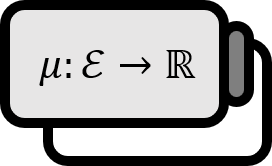Pi System and Lambda System
Definitions
- An entity satisfying $\mathcal{P}$ is called a $\pi$-system. $$ A, B \in \mathcal{P} \implies A \cap B \in \mathcal{P} $$
- An entity satisfying the following conditions is called a $\lambda$-system.
- (i): $\emptyset \in \mathcal{L}$
- (ii): $A \in \mathcal{L} \implies A^{c} \in \mathcal{L}$
- (iii): For all $i \ne j$, when $\displaystyle A_{i} \cap A_{j} = \emptyset$, then $\displaystyle \left\{ A_{n} \right\}_{n \in \mathbb{N}} \subset \mathcal{L} \implies \bigcup_{n \in \mathbb{N}} A_{n} \in \mathcal{L}$
Description
In measure theory, a System can be seen as a kind of algebraic structure defined over a collection. Of course, since abstract algebra couldn’t encompass everything, instead of calling it a group or a ring, these terms were separately created.
- The pi system may not appear to have conditions good enough to warrant having a system named after it, but being closed under intersection is stronger than it seems. Having the empty set as a must-have already talks volumes about its mathematical significance, as the empty set is often mentioned as the first condition in mathematical discussions, making it almost as if it has two properties already.
- The lambda system is very similar to a sigma algebra, with the main difference being that the sequence of sets must be disjoint($i \ne j \implies \displaystyle A_{i} \cap A_{j} = \emptyset$). This requirement makes imagining $\mathcal{L}$ much simpler.
